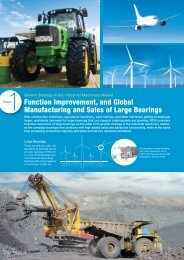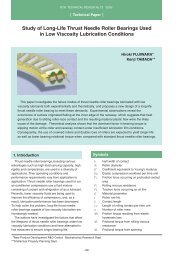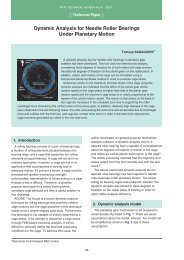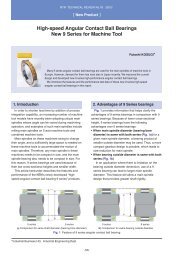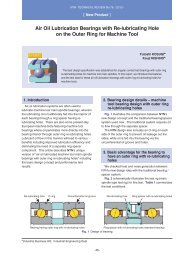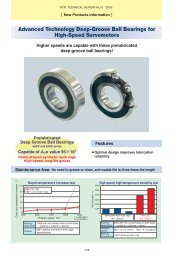Special Issue; Products for Industrial Machinery - NTN
Special Issue; Products for Industrial Machinery - NTN
Special Issue; Products for Industrial Machinery - NTN
You also want an ePaper? Increase the reach of your titles
YUMPU automatically turns print PDFs into web optimized ePapers that Google loves.
<strong>NTN</strong> TECHNICAL REVIEW No.742006<br />
3.1.1 Variation in the amount of base oil delivery<br />
depending on the heat cycle<br />
Grease-A in Table 1 was used to investigate the<br />
base oil delivery due to heat increase. The amount of<br />
base oil delivery in a model test rig subjected to<br />
repeated temperature increase and decrease<br />
(hereinafter referred to as the “heat cycle”) was<br />
compared with a model test rig in which the<br />
temperature was increased and then maintained that<br />
increased. The temperature was automatically<br />
controlled by a constant temperature chamber and the<br />
pattern of the heat cycle was as illustrated in Fig. 3(a).<br />
The temperature variation in each heat cycle (15˚C)<br />
was equivalent to the difference between the<br />
temperature in the grease chamber when the bearing<br />
was running (41˚C) and when the bearing was at a<br />
standstill (room temperature: 26˚C).<br />
The results of the amounts of base oil delivery<br />
relative to the radial clearance of 0.15 mm are<br />
summarized in Fig. 3(b). The model test rig (Photo 1)<br />
was set so that the flow path composed of the radial<br />
Temperature<br />
41˚C<br />
41˚C<br />
26˚C<br />
2 h 2 h<br />
clearance was situated vertically, and the oil content<br />
delivered to the clearance end point was removed with<br />
a piece of blotting paper once every 50 to 100 hours.<br />
The increases in the weight of the pieces of blotting<br />
paper were totaled and the resultant sum was taken<br />
as the amount of oil delivery.<br />
Immediately after grease prefilling, delivery of not<br />
only the base oil but also of the grease itself was<br />
observed. This portion was wiped away and was not<br />
included in the amount of delivery. The state of base<br />
oil delivery at the end point of clearance is shown in<br />
Photo 2. When the model test rig was not subject to<br />
the heat cycle, no delivery was observed after 100<br />
hours elapsed though a minor delivery occurred at the<br />
initial stage of testing. In contrast, when the model test<br />
rig was subject to the heat cycle, the delivery<br />
continued and the amount of delivered base oil was<br />
proportional to the time elapsed. In other words, when<br />
the heat cycle is applied to the grease chamber, the<br />
base oil in the grease is repeatedly separated from the<br />
grease and delivered through the clearance to<br />
function as a lubricant.<br />
Next, the effect of temperature differences in each<br />
heat cycle on the amount of base oil delivery was<br />
studied using the combination of Grease-A and a<br />
radial clearance of 0.15 mm. For comparison, the test<br />
was per<strong>for</strong>med with temperature differences in each<br />
heat cycle of 15˚C and 3˚C. The heat cycle pattern<br />
used <strong>for</strong> this test is shown in Fig. 4(a), and the result<br />
48 h 48 h<br />
(a)<br />
Time h<br />
Heat cycle pattern<br />
Amount of base oil delivery g<br />
0.4<br />
0.3<br />
0.2<br />
0.1<br />
With heat cycle<br />
Without heat cycle<br />
Photo 1 Model test rig <strong>for</strong> base oil delivery<br />
0<br />
0 100 200<br />
Time h<br />
(b)<br />
300 400<br />
Base oil delivery versus elapsed time<br />
Fig. 3 Base oil delivery with/without heat cycle<br />
Evidence of<br />
base oil delivery<br />
Photo 2 Delivered base oil<br />
-10-



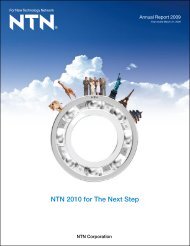
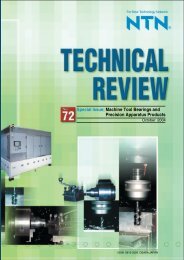
![[New Product] Unit Products for Office Equipment - NTN](https://img.yumpu.com/27154451/1/184x260/new-product-unit-products-for-office-equipment-ntn.jpg?quality=85)
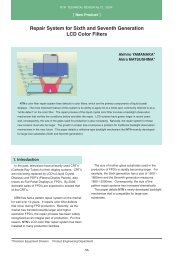
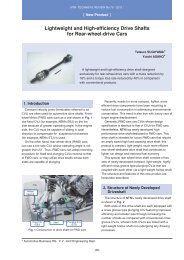
![[New Product] Development of Oil-impregnated Sintered ... - NTN](https://img.yumpu.com/27154427/1/184x260/new-product-development-of-oil-impregnated-sintered-ntn.jpg?quality=85)

